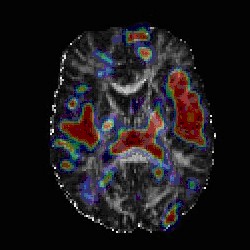Medical researchers at University of Pennsylvania in Philadelphia developed an algorithm based on magnetic resonance imaging (MRI) to differentiate cases of Alzheimer’s disease from front temporal lobe degeneration, which has similar dementia symptoms. The findings from the research team led by postdoctoral fellow and first author Corey McMillan appear online today in the journal Neurology (paid subscription required).
McMillan and colleagues devised a method that helps clinicians determine if a patient with dementia is suffering from Alzheimer’s disease or a condition known as frontotemporal lobar degeneration or FTLD, a collection of disorders affecting the frontal and temporal lobes of the brain often associated with personality, behavior, and language. The Association for Frontotemporal Degeneration says the condition affects 50,000 to 60,000 people in the U.S., and generally strikes people in their 50s or 60s, younger than the typical onset of Alzheimer’s disease.
The researchers from Penn’s Center for Frontotemporal Dementia, with colleagues from the university’s radiology and pathology departments, used MRI scans to predict the ratio of two protein biomarkers for the diseases in the cerebrospinal fluid: total tau for FTLD and and beta-amyloid for Alzheimer’s disease. Analysis of cerebrospinal fluid is the most accurate method for predicting potential for the conditions, but the test requires a more invasive lumbar puncture.
McMillan and colleagues recruited 185 patients with a neurodegenerative disease consistent with Alzheimer’s disease or FTLD, who had both a lumbar puncture to test the cerebrospinal fluid, as well as a non-invasive MRI. From this group, they identified 32 cases with Alzheimer’s disease or FTLD. The researchers then analyzed the MRI data and used a statistical technique called regression analysis to compare the MRI data to the biomarkers measured in the cerebrospinal fluid from the lumbar puncture.
The results showed the MRI prediction technique to be 75 percent accurate in identifying the correct diagnosis in patients with known to have the conditions and those with biomarker levels confirmed by lumbar punctures, indicating a comparable overlap in accuracy between the MRI and lumbar puncture methods. “Using this novel method,” says McMillan, “we obtain a single biologically meaningful value from analyzing MRI data in this manner and then we can derive a probabilistic estimate of the likelihood of Alzheimer’s or FTLD.” For the remaining 25 percent that are borderline cases, says McMillan, “a lumbar puncture testing spinal fluid may provide a more accurate estimate of the pathological diagnosis.”
The non-invasive MRI can be of particular benefit, say the authors, when used with clinical trials of new therapies. Biomarkers for neurodegenerative diseases have benefited from new developments such as spinal fluid tests detecting tau and amyloid-beta protein levels and other neuroimaging techniques. However, testing the efficacy of treatments for neurogenerative diseases will likely require multiple measurements over time, making a non-invasive technique such as MRI more attractive than lumbar punctures.
Read more:
- Merck, GE Healthcare Partner on Alzheimer’s Treatment Trial
- Enhanced MRI in Development for Faster Alzheimer’s Diagnosis
- Alzheimer’s Biomarker Project to Gain Whole Genome Data
- GE Healthcare, CSIRO to Partner on Alzheimer’s Diagnostics
- European Grant Awarded for Research on Enhanced MRI
* * *


 RSS - Posts
RSS - Posts
[…] MRI Helps Screen Alzheimer’s, Brain Degeneration Dementia […]